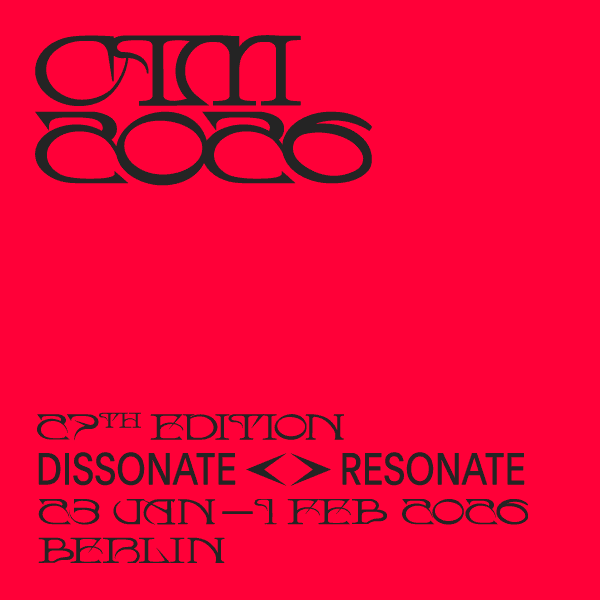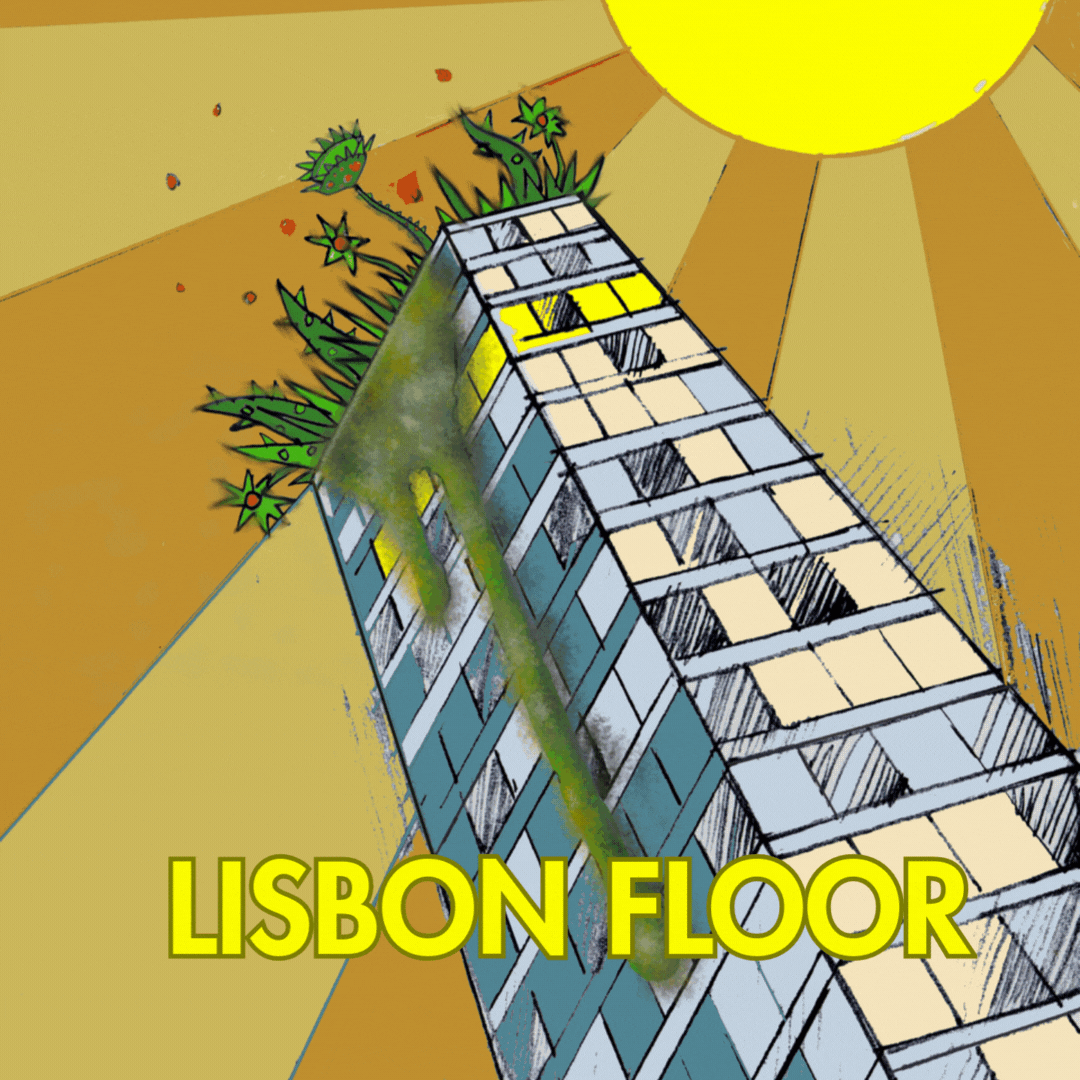Walking Blind
In its own understated way, sound art is an eternal revolt. When Jacob Kirkegaard turns his ultra-sensitive microphones toward the Earth’s interior, toward agriculture, or toward an abandoned reactor core, it is for the same reason that sound ecologists have, for decades, insisted on documenting changing landscapes: we need to be reminded that there is an entire world of information – of life, history, memory – that we have either forgotten to listen to or simply cannot hear with our limited ears.
Those who listen closely can see what blind progress overlooks
And we must understand that what we fail to hear are alternatives to the reality we see unfolding around us – a reality whose development we rarely feel we have any real influence on. The point: those who listen closely can see what blind progress overlooks.
This quiet resistance is the driving force behind Witness Stand, a sound art walk at Refshaleøen in Copenhagen, framed by Australian sound hippies Madeleine Flynn and Tim Humphrey. As politely as possible, they ask the group of roughly 40–50 people attending their three-hour evening performance on the outer tip of the island to keep their mouths shut and ignore their phones while following a guide to six different works by Maria Bertel, Ragnhild May, Katrine Grarup Elbo, P.O. Jørgens, Jørgen Teller, and the Melbourne duo themselves.
So that’s what we do. For three hours I don’t utter a word, keep my phone in my pocket, try to listen to everything around me, and immerse myself in the critical gaze on the gentrification of this old industrial area that runs as a thematic undercurrent through the works along the way. Yet from within, a discord begins to grow. For what exactly are we in this small resistance group part of here – the solution or the problem?
When you’re done gazing at rusty warehouses or pseudo-critical Spyo graffiti, you can take a dip at La Banchina’s harbour bath with a drink in hand
The sound of relentless progress
The stage is well chosen. In this century, Refshaleøen is transforming from a place of shipbuilding and military activity into a new neighbourhood for increasingly wealthy Copenhageners. While they wait to move into the artificial peninsula Lynetteholmen in 2070, this old, decaying – and contaminated – site serves as a nostalgia park for the rest of the city. When you’re done gazing at rusty warehouses or pseudo-critical Spyo graffiti, you can take a dip at La Banchina’s harbour bath with a drink in hand, or dine at Alchemist or Noma; sound art could hardly wish for a more obvious canvas to paint on.
The big rivets are engaged immediately. At a brisk pace through an impenetrable thicket – hello, Alice in Wonderland – we reach Maria Bertel, who has hung a handful of speakers right next to a mighty mast with a view over Nordhavn, Trekroner, and the colossal mound of earth that will one day become a peninsula filled with record-priced apartments. Bertel’s deep recorded drones – perhaps rasping bass notes from a trombone – immediately create a double listening: on the one hand, it sounds as though she has used the mast to tap into the Earth’s core, transmitting a sombre primal resonance; on the other, you hear a lost harbour past, a continuous foghorn.
She stands there in the mild wind, swaying slightly with a patinated brass trombone that can only just be glimpsed in the brief pauses of the recorded drones. Yet she blows passionately – the same deep tone as in the speakers – and looks like someone who has found something: a message, a law of nature. Could it be that relentless progress is what hides in the sound? With that view, it certainly sounds that way: ominous, elegiac, critical.
The classic sound of footsteps mixes with evening house music from the art hall Copenhagen Contemporary
Then the piece – conceived as a sonic lighthouse pointing in all directions – moves into a new phase. The clattering rasps vanish, replaced by a much gentler sound of octaves, thirds, a hopeful major resonance of beating tones in different tempi, occasionally even a breath. Warning turns to hope, still presented on the same grand scale – simple drones framing the urban development in front of us – but now with a new nuance of softness.
It’s as if the humanity that Bertel’s physical presence insists on inserting into the work – even though the acoustic sound is barely audible (as far as I can see and hear, the trombone isn’t connected to the speakers, though I may be wrong) – draws attention to the idea that development might not be a law of nature after all: it can change, if we want it to. A sharp, simple start to the walk.
Nostalgia unmasked
On the way to Ragnhild May, the classic sound of footsteps mixes with evening house music from the art hall Copenhagen Contemporary. Slightly disappointingly, we retrace our steps, walking so quickly that we never truly listen to the surroundings between works, even though they tell the same story about the dialectical meeting between industrial nostalgia and experience-economy entertainment. It feels like someone has tried to merge two formats – the eco-critical sound walk and performance art in public space – and in the process, we end up as hurried tourists in both worlds.
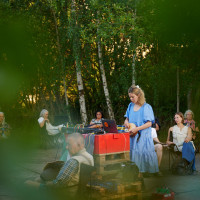
May hides in a patch of asphalt among wild trees, and in her quadraphonic electronic mix, we hear – as with Bertel – a critical eye on the transformed harbour. Ship rotors mix with sonar pings, deconstructed into something like distant tribal rhythms before May sketches a new space: deep bass against bright glass, a dynamic span allowing for great complexity in the roughly twenty minutes allotted for each stop on the tour. The work’s strength lies in how, in one motion, it finds signs of life in the harbour sounds it swirls around, and in the next, pulls the rug out from under them by pushing the tones in a synthetic direction. Our imagined, nostalgic memory of industrial working life becomes a warped hall of mirrors.
At its height, a manic, bright electronic melody – as if from a short-circuited spinning top with sound – and cutting beats from yet another of May’s homemade flute instruments sneak into the performance before the music slowly softens into a long outro. I find myself watching an ant colony that has built a highway along the speaker cables on the asphalt: everything changes constantly; the ghosts May finds behind the façade may haunt us most of all with an unnatural desire to hold on to what once was – in a way entirely different from how it actually was – instead of adapting to something new. The distance from rebellion to conservatism is short.
Self-awareness in the nostalgia park
May captures an ambiguity that the walk’s very title – Witness Stand – doesn’t quite accommodate. It carries a command to tell the truth and help convict the accused – clearly urban development. This can easily become one-dimensional, and that’s also what hampers Katrine Grarup Elbo’s contribution, despite it taking place in the most spectacular location: a long, underground pipework chamber.
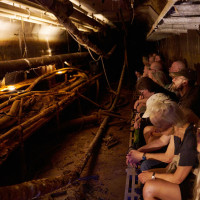
Here, a violin enters in the midst of a metallic-electronic underwater portrait, just as growing feedback or reverb had carried us further and further into an unknown world. Suddenly, the violin’s marked vibrato and gliding melody colours the experience towards the romantic, and the pairing of sentimental lament and decaying water pipes turns pathetic.
Nostalgia takes over, and suddenly I realise that the walk seems stripped of self-awareness. How is what we, the intrepid walkers, are doing here any different from what the creative class around us is using Refshaleøen for? Aren’t we just another way of making the area attractive for future homebuyers? And how does the works’ fascination with the area’s oh-so-authentic industrial working past figure into that equation?
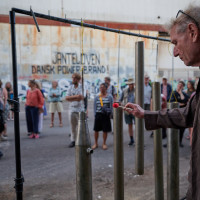
As we approach the old B&W shipyard hall, now functioning as a paintball arena, and see that P.O. Jørgens has installed a speaker in a dug-up road – with access to old piping – the whole thing looks little more than urban exploring fetishising the working class. We’re quickly herded away from the installation – which, with its recordings of sloshing water, dragged metal, music-box tunes, and added reverse audio, resembles a quick answer to an open call on the themes of harbour, industry, and memory – because the artist is waiting further down the street with an abundance of DIY metallic instruments.
We’re told to play with them: rusty metal discs, a screeching rotating sculpture, pitch-bending pipes. When Jørgens, from his setup behind thunder sheets, starts kicking tin cans into the crowd, the walkers join in, and a clatter rises. I mentioned the nostalgia park earlier, but here the walk resembles nothing more than an actual fairground; the thematic thread has largely unravelled.
At the other end of the vast Copenhell asphalt lot, hard house thumps from the Karrusel forest
From wackiness to art film
To the sound of P.O. Jørgens in the midst of a frenzied oil-drum solo, we round the corner of the hall and find Jørgen Teller being… well, Jørgen Teller. With wackiness in ascendance, he’s tied a tin lid to a string, tossing it playfully around between microphones that pick up the sound, loop it, and create a fragmented percussion score. Later, he drags his red electric guitar – fitted with skateboard wheels – toward the horizon, its metallic-synthetic rattling turning into a slow plane crash over the speakers.
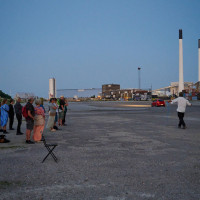
»It’s one I use to make trouble,« he explains when I break my vow of silence to stay behind at the rolling instrument and inspect it, while the walkers are lured further up a hill by Tim Humphrey on trumpet. At the other end of the vast Copenhell asphalt lot, hard house thumps from the Karrusel forest. The sun has set, everything is starting to fall apart now. What does any of this have to do with anything?
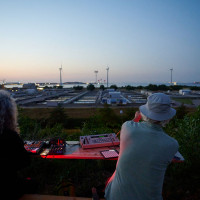
And yet, it comes together at the top of the hill, where Madeleine Flynn sits behind a small synthesizer. Humphrey adds to her ambient tones – occasionally bending slyly – with trills from a trumpet and an electronic EWI wind instrument, and together they give the cinematic view – reminiscent of the Bertel stop, though now with the Lynetten sewage plant in the foreground – a melancholic-mystical glow.
As darkness falls over the island and the city, both begin to resemble a long, grainy shot from an art film
As darkness falls over the island and the city, both begin to resemble a long, grainy shot from an art film: civilisation reduced to flickering lights, humanity to artificial signals. But the wind turbines keep turning – slowly but unstoppably – and the cicadas keep singing. Everything becomes a heavy, unreal fog that envelops us. By the time we’re back down the hill, the Karrusel forest’s house has turned into fierce trance. The ship has sailed.
»Witness Stand«, 13–17 August at Refshaleøen. Produced by the performance laboratory Metropolis, run by Københavns Internationale Teater.
English translation: Andreo Michaelo Mielczarek
